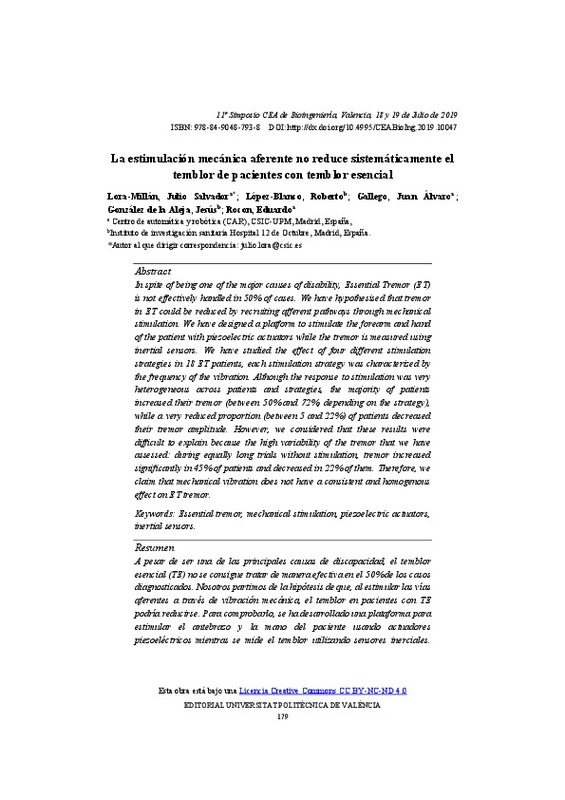JavaScript is disabled for your browser. Some features of this site may not work without it.
Buscar en RiuNet
Listar
Mi cuenta
Estadísticas
Ayuda RiuNet
Admin. UPV
La estimulación mecánica aferente no reduce sistemáticamente el temblor de pacientes con temblor esencial
Mostrar el registro sencillo del ítem
Ficheros en el ítem
| dc.contributor.author | Lora Millán, Julio
|
es_ES |
| dc.contributor.author | López Blanco, Roberto
|
es_ES |
| dc.contributor.author | Gallego, Juan
|
es_ES |
| dc.contributor.author | González de la Aleja, Jesús
|
es_ES |
| dc.contributor.author | Rocon, Eduardo
|
es_ES |
| dc.date.accessioned | 2019-11-14T13:37:13Z | |
| dc.date.available | 2019-11-14T13:37:13Z | |
| dc.date.issued | 2019-11-13 | |
| dc.identifier.isbn | 9788490487938 | |
| dc.identifier.uri | http://hdl.handle.net/10251/131062 | |
| dc.description.abstract | [ES] El temblor esencial (ET) es una uno de los desórdenes motrices más prevalentes en adultos, con tratamientos poco efectivos en la mitad de los casos. En este documento, estudiamos si la estimulación mecánica aferente puede reducir el temblor en pacientes de ET al estimular selectivamente las vías aferentes. Para ello, hemos diseñado una plataforma que permite estimular la mano y el antebrazo del paciente utilizando actuadores piezoeléctricos mientras monitorizamos el temblor mediante sensores inerciales. Hemos analizado el efecto de cuatro estrategias de estimulación, incluyendo estimulación a frecuencia constante y variable, en 18 pacientes de ET. A pesar de que no existe una clara respuesta a la vibración ante las diferentes estrategias, en la mayoría de los casos (50-72%) la estimulación mecánica se asocia a un aumento en la amplitud del temblor. Por el contrario, el temblor se reduce entre el 5 y el 12% de los pacientes. Sin embargo, estos resultados son difíciles de interpretar debido a la variabilidad intrínseca del temblor: durante ensayos de la misma duración, el temblor varió significativamente en el 67% de los pacientes (aumentando en el 45% y disminuyendo en el 22%). Por tanto, la estimulación mecánica de la extremidad no tiene un efecto sistemático en el temblor propio del Temblor Esencial. | es_ES |
| dc.description.abstract | [EN] In spite of being one of the major causes of disability, Essential Tremor (ET) is not effectively handled in 50% of cases. We have hypothesised that tremor in ET could be reduced by recruiting afferent pathways through mechanical stimulation. We have designed a platform to stimulate the forearm and hand of the patient with piezoelectric actuators while the tremor is measured using inertial sensors. We have studied the effect of four different stimulation strategies in 18 ET patients, each stimulation strategy was characterized by the frequency of the vibration. Although the response to stimulation was very heterogeneous across patients and strategies, the majority of patients increased their tremor (between 50% and 72%, depending on the strategy), while a very reduced proportion (between 5 and 22%) of patients decreased their tremor amplitude. However, we considered that these results were difficult to explain because the high variability of the tremor that we have assessed: during equally long trials without stimulation, tremor increased significantly in 45% of patients and decreased in 22% of them. Therefore, we claim that mechanical vibration does not have a consistent and homogenous effect on ET tremor. | es_ES |
| dc.format.extent | 11 | es_ES |
| dc.language | Español | es_ES |
| dc.publisher | Editorial Universitat Politècnica de València | es_ES |
| dc.relation.ispartof | 11º Simposio CEA de Bioingeniería | |
| dc.rights | Reconocimiento - No comercial - Sin obra derivada (by-nc-nd) | es_ES |
| dc.subject | Bioingeniería | es_ES |
| dc.subject | Interfaces cerebro-máquina | es_ES |
| dc.subject | Tecnología | es_ES |
| dc.subject | Rehabilitación | es_ES |
| dc.subject | Asistencia | es_ES |
| dc.subject | Biomecánica | es_ES |
| dc.subject | Bioseñales | es_ES |
| dc.subject | Robótica | es_ES |
| dc.subject | Imagen médica | es_ES |
| dc.subject | Sensores | es_ES |
| dc.subject | Instrumentación | es_ES |
| dc.subject | Modelado | es_ES |
| dc.subject | Simulación | es_ES |
| dc.subject | Control | es_ES |
| dc.subject | Telemedicina | es_ES |
| dc.subject | Biomateriales | es_ES |
| dc.subject | Transferencia | es_ES |
| dc.subject | Experiencia clínica | es_ES |
| dc.title | La estimulación mecánica aferente no reduce sistemáticamente el temblor de pacientes con temblor esencial | es_ES |
| dc.type | Capítulo de libro | es_ES |
| dc.type | Comunicación en congreso | es_ES |
| dc.identifier.doi | 10.4995/CEABioIng.2019.10047 | |
| dc.rights.accessRights | Abierto | es_ES |
| dc.description.bibliographicCitation | Lora Millán, J.; López Blanco, R.; Gallego, J.; González De La Aleja, J.; Rocon, E. (2019). La estimulación mecánica aferente no reduce sistemáticamente el temblor de pacientes con temblor esencial. En 11º Simposio CEA de Bioingeniería. Editorial Universitat Politècnica de València. 179-189. https://doi.org/10.4995/CEABioIng.2019.10047 | es_ES |
| dc.description.accrualMethod | OCS | es_ES |
| dc.relation.conferencename | 11 Simposio CEA de Bioingeniería | es_ES |
| dc.relation.conferencedate | Julio 18-19,2019 | es_ES |
| dc.relation.conferenceplace | Valencia, Spain | es_ES |
| dc.relation.publisherversion | http://ocs.editorial.upv.es/index.php/CEABioIng/CEABioIng/paper/view/10047 | es_ES |
| dc.description.upvformatpinicio | 179 | es_ES |
| dc.description.upvformatpfin | 189 | es_ES |
| dc.type.version | info:eu-repo/semantics/publishedVersion | es_ES |
| dc.relation.pasarela | OCS\10047 | es_ES |








